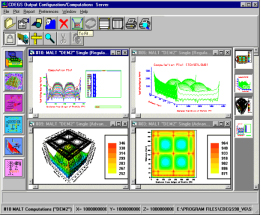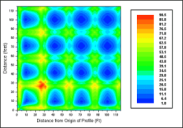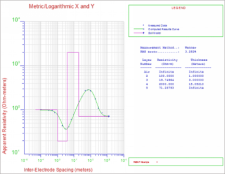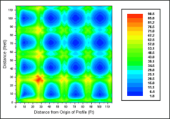Industrial Earthing System Designing

Earthing System - the most important part of an electrical system
When you build a new building, the foundations are the most important part. If you have a poor foundation, many issues will occur in the future.
Electrical systems are no different. Your earthing is the most important part of an electrical installation. It is also the root of many power quality and safety issues. DEW can design your earthing system from a green site to an existing building as per IEEE-80, IEEE-142 & IS-3043 standards.
An effective earthing system is critical to the safety of every electrical installation. Every building, equipment, power plant, substation facility included in electricity require earth grounding, either directly or through grounding system.
Any Earthing system should achieve the following objectives.
- A maintenance free system with predictable lifespan
- To eliminate the possibility of electric shock to personnel
- To assures timely tripping of protection devices for the safety of man and machine
- To equalize the voltage potential of normally non‐current current carrying metalwork
- To provide an earthing network free of earth loops and electric noise
- To provide a Zero-volt common reference point for safe operation of CNC machines
- To prevent electrostatic charge of process plant to fluid movement in hazardous areas
- To provide earthing for the proper functioning of the Surge protection devices
DEW earthing system designing
 The engineers at DEW can help you plan and execute an electrical grounding design that will provide the best performance ground system available, within the constraints of your available area, budget, and equipment being protected. Our international standard design capability is supported by most advanced electrical earthing analysis software package CDEGS for earth electrode system designing, ETAP for fault current analysis and high-end instruments for on-site measurements.
The engineers at DEW can help you plan and execute an electrical grounding design that will provide the best performance ground system available, within the constraints of your available area, budget, and equipment being protected. Our international standard design capability is supported by most advanced electrical earthing analysis software package CDEGS for earth electrode system designing, ETAP for fault current analysis and high-end instruments for on-site measurements.
We have rich experience to dealing with a variety of issues in this field. We are passionate for providing our customers with innovative services which deliver tangible benefits for their businesses and installations.
We have worked for India’s largest transmission and distribution companies like GE T&D, KEC, GETCO etc. Our Earth Electrode System Designs comply with the relevant National and International Standards i.e. IEEE-80, IEEE-142 & IS-3043
We follow below mentioned procedure to build an electrical grounding system that will meet your performance objectives.
- Soil resistance testing with Wenner method
- Soil resistivity layer analysis with CDEGS-RESAP engineering software
- Fault current analysis with ETAP software
- Conductor sizing based on fault current and life expectancy
- Earthing grid design and analysis with CDEGS-MALZ engineering software
- Earth current density calculations
- AutoCAD Layout of Earthing grid
- Earthing system installation & commissioning
CDEGS - RESAP | Multilayer Soil Resistivity Analysis
The starting point to designing any Earth Electrode System is to determine the resistivity of the ground that the earthing is to be installed in.
 It is of vital importance that a ‘clean’ set of soil resistivity measurements are taken, as these readings have a direct influence on the quantities of earthing Conductor that are to be installed in the ground. We only use the Megger DET2/2 earth tester, a high-end test instrument capable of filtering out unwanted electrical noise that may foul the results gained.
It is of vital importance that a ‘clean’ set of soil resistivity measurements are taken, as these readings have a direct influence on the quantities of earthing Conductor that are to be installed in the ground. We only use the Megger DET2/2 earth tester, a high-end test instrument capable of filtering out unwanted electrical noise that may foul the results gained.
Our team of Engineers and Technicians will attend your site and carry out a full electrical assessment of the ground. The raw data is processed using a bespoke module RESAP built into the CDEGS software package, this enables the formulation of a multi-layered soil model, allowing for a much more efficient Earth Electrode System Design going forward.
All work is carried out by our trained and competent Engineers and Technicians in accordance with IEEE-81 standard.
CDEGS - MALZ | Earthing Grid Designing & Analysis Software
 CDEGS - MALZ is the world’s leading software for grounding system design and safety analysis. Soil resistivity data is inputted into RESAP and the grounding system design is completed using MALZ modules. Grounding impedance, Ground Potential Rise and Step/Touch voltages are computed to verify the safety of the grounding system.
CDEGS - MALZ is the world’s leading software for grounding system design and safety analysis. Soil resistivity data is inputted into RESAP and the grounding system design is completed using MALZ modules. Grounding impedance, Ground Potential Rise and Step/Touch voltages are computed to verify the safety of the grounding system.
With MALZ we can analyze the frequency domain performance of buried bare and coated conductor networks. The end results are bespoke designs, which are based on Dew extensive experience of earthing system designing.
Dry conductive concrete earthing
 FurseCEM is a non-corrosive permanent solution to earthing problems, providing a fixed earth reading that will not vary significantly regardless of seasonal factors, and without maintenance. It is a conductive material and is not affected by moisture in soil as in the case of ionic based earthing like chemical earthing and salt charcoal-based earthing which requires water and electrolytes like salt or chemicals to conduct the electricity.
FurseCEM is a non-corrosive permanent solution to earthing problems, providing a fixed earth reading that will not vary significantly regardless of seasonal factors, and without maintenance. It is a conductive material and is not affected by moisture in soil as in the case of ionic based earthing like chemical earthing and salt charcoal-based earthing which requires water and electrolytes like salt or chemicals to conduct the electricity.
Features and benefits
- Permanent Earth reading
Resistivity that will remain constant over the life of the installation without the requirement of maintenance - Constant Volume
Regardless of water content, FurseCEM will not shrink or expand thus maintaining constant contact between the earth electrode and the soil - Cost effective
Reduces drilling, saves on earthing materials, and requires no expensive maintenance Non leaching. FurseCEM is a conductive concrete and therefore cannot be washed away - Chemically inert
Completely non-corrosive, and will not in any way damage earth electrodes, steelwork, or concrete - Mechanical strength
Provides high compressive strength where required - Versatile installation
Suitable for use in boreholes and trenches
System Commissioning
Once the system has been fully installed, confirmation should be sought as to whether the design resistance and installed system resistance are comparable. This is done via direct measurement using fall of potential method as per IEEE-81 standard.
To gain a true measurement of the installed Earth Electrode System, it is necessary to run test leads many tens of meters away from the system under test, avoiding any buried metal objects or overhead power lines. The Engineer attending site will evaluate the area available for testing and determine the best method of test for that specific Earth Electrode System.
Once the test is complete using our powerful and accurate test equipment, a certificate of compliance will be issued, many Electricity Companies will not energize your site without this certificate.
